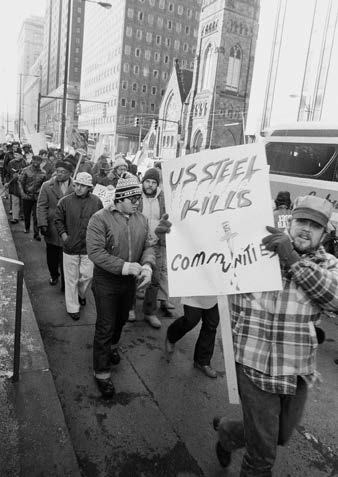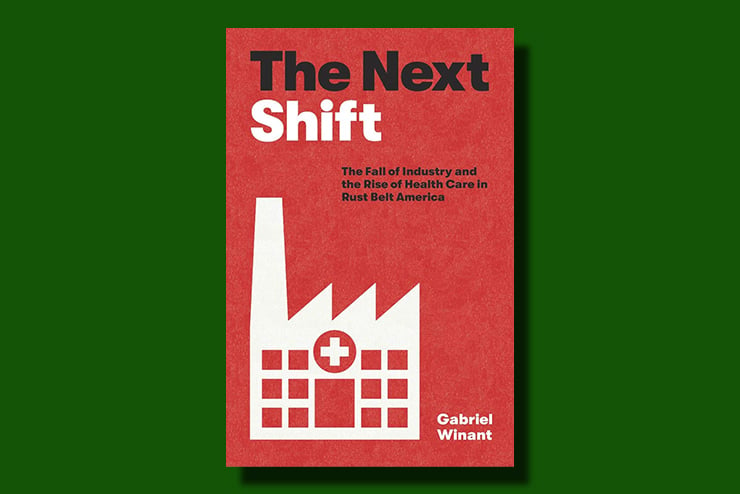The Next Shift: The Fall of Industry and the Rise of Health Care in Rust Belt America
by Gabriel Winant
Harvard University Press
368 pp., $35.00
Once upon a time, there were academic historians on whom the public could rely for help in accurately understanding the world in which we live. Scholars such as Samuel Eliot Morison and Henry Steele Commager wrote serious books that anyone could read and find of genuine utility.
Then, in the wake of the ’60s and ’70s, radicals who had lost the revolution in the streets began boring into the institutions and spreading their subversion especially within the schools. They swamped the humanities and social science disciplines, which were the most easily politicized, including history departments. When the generation of scholars who came before them died off, the radicals became the elder statesmen in those fields. This victory by attrition gave them the institutional power to change the curricula and the graduate-student training programs. It also allowed them to systematically recruit new faculty still more radical than themselves.
The result: many campuses have wound up with whole departments of history, among other disciplines, that are filled with activist radicals posing as scholars. These activists write to inform us of how wrong we have been about all the topics we once thought we knew something about, and they invent a plethora of new topics the benighted did not realize existed. In both spheres, the pseudo-scholars produce a proliferation of academic books uniformly championing the same woke principles, placing every topic under the sun within the purview of those principles.
The young author of The Next Shift, Gabriel Winant, exemplifies this transformation of academic historiography. The newly-minted professor at the University of Chicago, a “historian of the social structures of inequality in modern American capitalism,” according to his online bio, writes for The Nation, Dissent, and Jacobin, among other radical-left publications. In Jacobin, he has done substantial electoral cheerleading for Democratic Socialists of America (DSA) candidates, and he was a member of that organization’s Central Connecticut branch while he was in graduate school at Yale.
The Next Shift describes the transformation of Pittsburgh’s blue-collar economy over the course of the later 20th century from the dominance of steel to that of health care. The linkage Winant sees between the two historical economies will likely not surprise you, given his DSA credentials: it is the merciless, unceasing exploitation and degradation of labor and laborers by employers and by the capitalist process itself.
Some parts of this story hold up to scrutiny, but those that do not are far more numerous. Steel collapsed for an array of reasons, one of which was undeniably that unionized workers in the industry demanded ever-higher wages and benefits. Winant acknowledges this, but only in passing and quite incompletely. In the face of those increasing wages, management pushed to rationalize work and to increase productivity, which meant fewer workers working harder. Strikes became more frequent, and the inevitable end was achieved: steel, faced with less aggressively militant labor elsewhere, was economically disadvantaged; the working-class prosperity of the American industry disappeared; and new forms of work took steel’s place. Winant blames only the bosses for this intimately interactive development; the unions, in his view, are wholly without blemish.
The story of steel’s disappearance is complicated and fascinating, but Winant seems interested in it only in a perfunctory way. Other things are of much greater concern to him. The only real change Winant notes in the move from steel to health care—other than in the specifics of the work the laborers are doing—is that the exploitation has gotten still more nefarious and morally condemnable. Why? Because now the exploited laborers are significantly female and non-white.
 The abuse of steelworkers, though meriting some sympathy, was nonetheless more morally complex given that, as the book luridly details, the white male steelworkers were themselves violent oppressors of others. The white working class steel families are characterized here as dominated by the patriarchal discipline of husbands, who ruled the domestic roost through violence. These claims are based on a handful of anecdotes, and some of Winant’s ideological interpretive effort here is frankly embarrassing. One worker, for example, is described as taking “pleasure in performing bodily dominance” over his spouse. He performed this reprehensible act of illegitimate power by lovingly patting her on the bosom as they drove. Thus are 2022 #MeToo cultural standards turned into an ahistorical whip with which to flog the entirety of America’s past for not conforming to the rules of the present.
The abuse of steelworkers, though meriting some sympathy, was nonetheless more morally complex given that, as the book luridly details, the white male steelworkers were themselves violent oppressors of others. The white working class steel families are characterized here as dominated by the patriarchal discipline of husbands, who ruled the domestic roost through violence. These claims are based on a handful of anecdotes, and some of Winant’s ideological interpretive effort here is frankly embarrassing. One worker, for example, is described as taking “pleasure in performing bodily dominance” over his spouse. He performed this reprehensible act of illegitimate power by lovingly patting her on the bosom as they drove. Thus are 2022 #MeToo cultural standards turned into an ahistorical whip with which to flog the entirety of America’s past for not conforming to the rules of the present.
above: Steel workers rally outside the United States Steel Corporation headquarters in Pittsburgh on Nov. 30, 1979, to protest the company’s decision to close 16 plants, including one in Youngstown, Pa. (Uncredited / Associated Press)
This suspect critical method has become the common currency in academic history. Here is the blueprint for such analysis: Pick a few stories from appropriately biased sources (e.g. one of the memoirs on which Winant relies most heavily is by a child who grew up to become just what Winant did, a radical labor-studies professor) that back up the story you take as true before the fact and studiously avoid any information that does not fit your unfalsifiable hypothesis.
Winant will not hear of it when some of his subjects, even the leftist memoirists among them, insist on singing the praises of postwar American economic prosperity, which was so strong as to pull up considerably even the least advantaged. “Something does not add up,” we are told, for men “curse the [steel] mill as well as worship it.” But this purported arithmetical problem is not hard to solve. The work steelworkers did was well-remunerated precisely because it was physically difficult and unpleasant. Of course the world Winant longs for, in which all work is a pleasurable way to pass the time while drawing a high salary and great benefits, is better than the one in which Pittsburgh steelworkers existed. But there is no evidence to believe it any more plausible than a perpetual motion machine.
The book takes aim at “the ideology of the heroic breadwinner” in the ’50s as well. Winant cites from another memoir a story of a child reminiscing about the smell of the grilled cheese sandwich his mother made for his father when he returned from the mill at midnight. For the boy, this was a sign that everything was right in the world. Winant chides him for overlooking the mother’s domestic labor.
Racism as well plays a familiar role here as an explanation for anything and everything. It is the cause of every misfortune blacks in Pittsburgh faced during the period of the book’s analysis. Deindustrialization was caused by racism and certainly not by the combination of unionism and American capitalism’s abandonment of the working class in preference for the liberal ideology of global free trade. White flight from integrating neighborhoods was also motivated by racism, in Winant’s account, not by events such as the Pittsburgh riot, which went on for a full week following Martin Luther King, Jr.’s assassination, producing more than 500 fires and 900 arrests before it was quelled by the National Guard. Perhaps the most glaring absence in the book is the contribution made by immigration policies to the exploitation of health-care workers. The word “immigration” does not even appear in the index, yet the topic is central to the state of the labor field about which Winant writes. Immigrants are only 17 percent of the whole American workforce, but they are significantly overrepresented in health-care fields at both ends of the socioeconomic spectrum. Nearly 30 percent of American physicians and almost four-in-ten home health aides are immigrants. According to a 2018 Migration Policy Institute analysis, somewhere around 2.5 million immigrants are employed in health care.
Immigrant women are particularly overrepresented in direct health-care support positions. These jobs are the prototype of low-wage, low-status health-care work on which Winant concentrates much attention, yet he apparently did not even notice this aspect of that labor. Noticing such a thing would require recognizing how much one well-loved progressive public policy— wide-open immigration, especially from poorly educated Third World countries— conflicts with another: the desire to minimize labor exploitation of vulnerable workers, both foreign-born and native.
Concentrated federal action could force the health-care industry to privilege native-born labor and penalize the industry for taking economic advantage of vulnerable foreign workers. This would greatly improve conditions for the workers with whom Winant sympathizes, but at the cost—for those with his ideological perspective—of fewer immigrants.
The story of the dispossession of American labor at the hands of a globalist, open-immigration coalition of politicians and employers who are happy to play along with a left-wing political narrative, so long as it increases their bottom line, is of obvious interest to nationalist conservatives. The ideological blinders of The Next Shift unfortunately prevent it from shedding light on the topic’s most important questions.

Leave a Reply